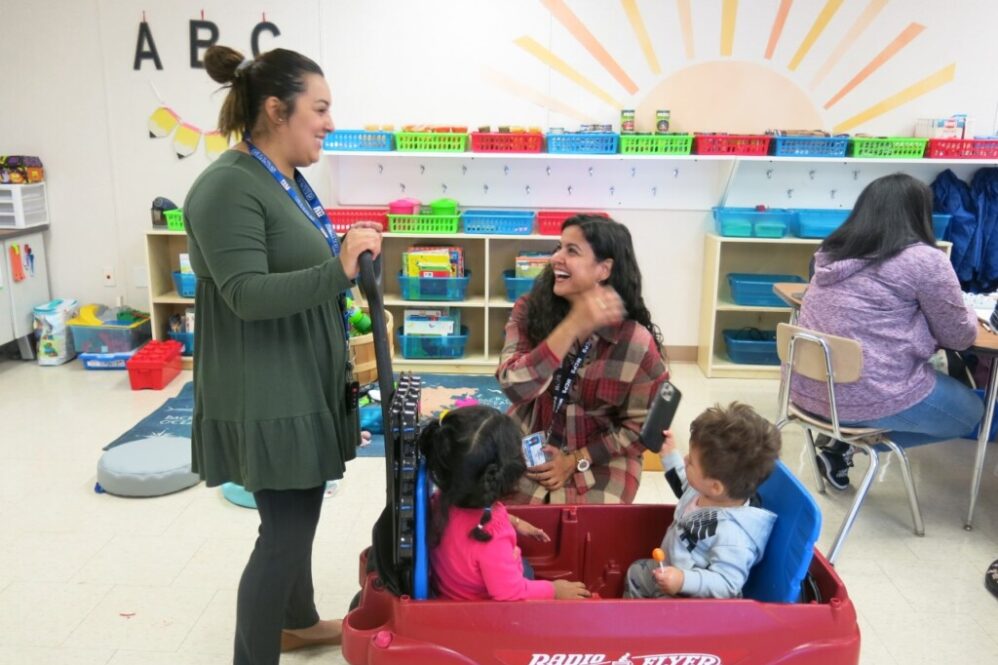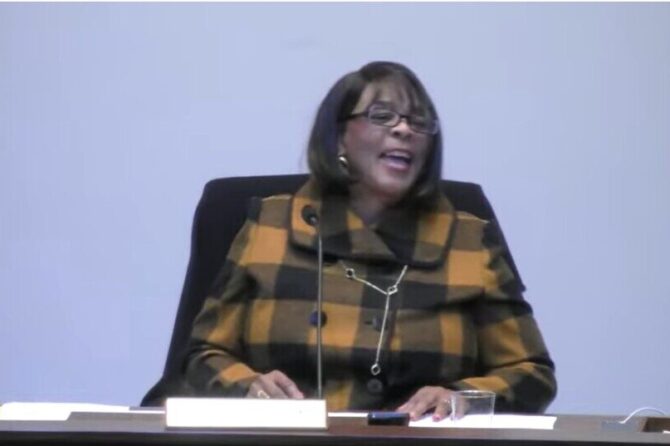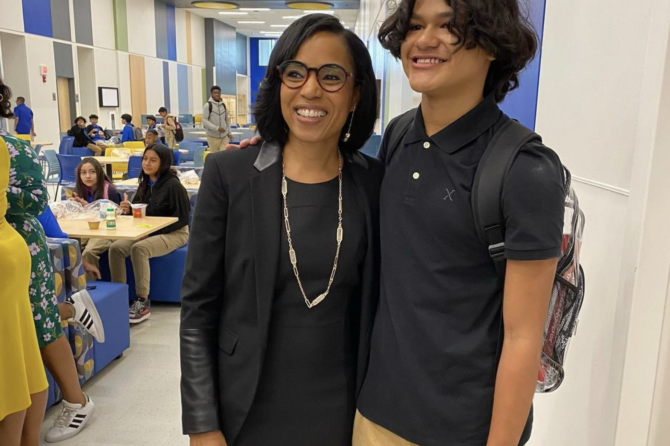Maryland Matters: Every morning before school Wolfe Street Academy in Baltimore opens for breakfast. Today sausage sandwiches, bananas, juice and milk are on the menu for the students, all of whom are eligible for two free meals a day. Many come with their parents, and sit together for announcements, which Principal Mark Gaither and ESOL family liaison Sylvia Chicas deliver bilingually, since Latinos make up over 80% of the student body.
On this day Gaither applauds regular attendance, rewards good behavior with gift cards, and singles out students for their achievements. He says it’s not unusual for parents to stick around.
“We get tons of parents, and one will [announce], ‘We have an ESOL meeting afterwards,’ and we’ll have 60 parents who stay,” Gaither said. “Our families are wonderful. They reach out. We show up for each other for the thing that we are calling the school year and life, and we do it together. We work the problem, come up with the next best plan and keep going.”
Ingredients for scholastic success
What Gaither is running is a community school. It’s at the core of the Blueprint for Maryland’s Future Act, the multi-billion-dollar public education reform plan, enacted in 2021. The new law prioritizes pockets of poverty, giving schools services they need to thrive. Gaither says academic success depends on considering the whole family and problems like nutrition, health, and unemployment, food and housing insecurity.
“All we are doing is giving them the things that you expect for all kids,” he said. “You wouldn’t let your kid take a high stakes test without eating, would you?” At Wolfe kids get free eyeglasses, join after school activities that include art, creative writing, theater, music, plus opportunities to play soccer, baseball and chess.
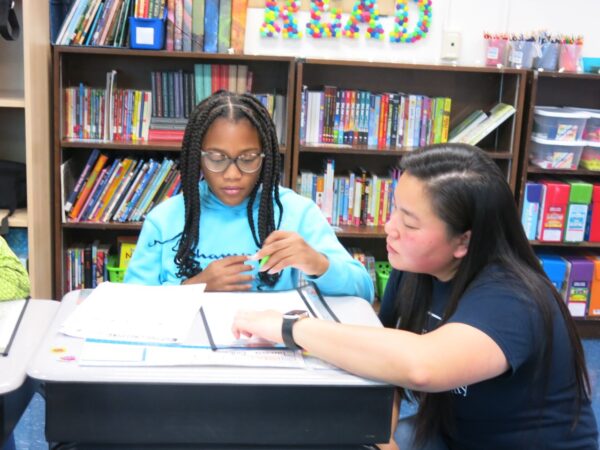
Wolfe Street Academy fifth grader and aspiring mathematician, Tamera, works out a problem with teacher Jen Boebinger. Photo by Rosanne Skirble.
When Gaither came to Wolfe in 2005, the school ranked 77th among the city’s 90 elementary schools. Leveraging public funds and community support, Wolfe became a community school the next year. He says the move has transformed student and family life, noting that by 2014 Wolfe ranked second academically, behind the most affluent school in the city. “We have maintained that trajectory,” he said. “The Maryland Report Card, released by the Maryland Department of Education, puts Wolfe above 70% of the public schools in the state.”
The school has been so successful that students beyond Wolfe’s neighborhood compete in a lottery to enroll there.
The new Blueprint law with its complex funding formula based on a specific concentration of poverty level provides each school with a community school coordinator and a healthcare practitioner. “By virtue of being a public school in Baltimore City, we are part of the Blueprint and [did] not need to apply,” Gaither said. “All of our after school programming is separate from this funding, and [comes from] individual grants.”
Building community partnerships
Aneuri Castro is the community school coordinator. His job is to keep an eye on what the students and families need and seeks to provide it.
As a first generation Dominican-American, with a degree in social work, he is especially equipped to help Wolfe succeed by getting to know its neighbors. “The best way is the good old-fashioned way, which is setting up a meeting, picking up a phone, calling people, letting people know who we are, what we do and what we’re looking into getting into,” he said, adding that at the end of baseball season, he arranged for 40 Orioles tickets for kids and families.
He’s raised funds to help families pay rent and utilities, and cooperates with the University of Maryland School of Social Work and Johns Hopkins University School of Public Health, where he recently recruited 15 graduate students to help in the after school programs. Among their other partners are the Baltimore Curriculum Project, the Upper Fells Point Improvement Association, Vision for Baltimore, and the Baltimore Family Alliance.
These efforts give students a sense of stability, which is what we hear from students in Jen Boebinger’s 5th grade class, many of whom have been at Wolfe since pre-K. Ten-year old Sophia says, “My parents immigrated from Brazil, and we didn’t have a lot of money. And, now we’re doing a lot better because of Wolfe Street.” She makes friends easily among different cultures. “There’s lots of people from lots of different places. We have people from El Salvador, from Mexico and all places around the world,” she said. Tamera, age 11, a minority African American in the largely Latino school, nods her head in agreement. “It’s fun and easy to learn a new language in this school,” she said.
Boebinger is proud of her students. “I hope that we can build confidence in all of the different things that we do,” she said. “I want them to leave Wolfe feeling really great about themselves. I hope we can continue doing this work, continue supporting our families in the way that we do and continue learning together.”
Clopper Mill Elementary, school re-set
Wolfe Street Academy is a model for the 358 community schools across Maryland, including 58 added in the 2022-3 school year with the implementation of the Blueprint law. It’s year one for Clopper Mill Elementary in Germantown, which is among 26 community schools in Montgomery County. The school is largely Hispanic and African American. Most students qualify for free and reduced lunches.
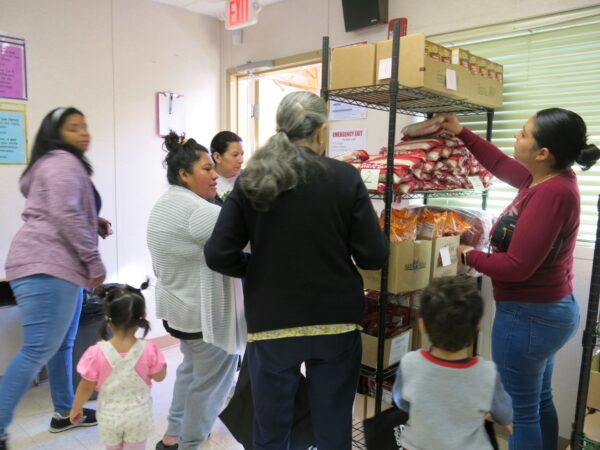
The free food pantry is a hit with parents at Clopper Mill Elementary School in Germantown, which reorganized as a community school this fall. Photo by Rosanne Skirble.
On a recent day, Principal Lawrence Chep was talking with several dozen parents at an early morning coffee, the first of regularly scheduled monthly meetings to garner interest and concerns. “When you have parents who are really invested in the school, and have a positive view of our school and the connection we have with them, then the children see that and they get more excited about school and learning,” he said.
On that same morning, the school’s community liaison, Jennifer DeCastro, opened the free-food pantry, which operates in a portable classroom twice a week with stocks of staples like fresh milk and yogurt, rice, and canned vegetables and fruit. She also takes her cues from the parents, and what’s happening, like getting quality jump ropes, and making sure the afterschool sports clubs have scrimmage vests. “It takes a team to do this,” she said. “We work closely with the Parent Community Coordinator, counselors, the PTA and leaders among our school families.”
DeCastro counts among her partners Capital Area Food Bank, MD Diaper Bank, Montgomery Soccerplex, Leveling the Playfield, and Master Method Academy and continues the search for more resources.
Parents engaged, volunteer
This year Yesika Morales’ 4-year-old is in pre-K. As she gathers food from the pantry, she says she feels the school is focused on children and families. “Parents are motivated to take charge, to be present and support the school,” she said.
These parents include Karina Artiga-Morales, a daycare provider, who loaded two toddlers in a red wagon to be here. “I bring my [older] daughter on Fridays too, and we help so that my kids can grow up by giving back to the community, not just [taking],” she said. Standing nearby, volunteer Kathy Holloway, whose daughter is in the fourth grade after two years of virtual school, sums up their engagement, “It takes a community to raise a child,” she said. “I think it’s going to be great!”
Cost, wellness benefits
Their dreams are encapsuled in the Blueprint Act, which comes with a big price tag, increasing educational funding to $3.8-billion a year by 2030. Senate President Bill Ferguson (D-Baltimore City), a former teacher who helped craft the new law, told Maryland Matters that community schools offer a beacon for the future.
“In the 21st century, it’s not just about math and science scores, although those matter, as much as anything. It’s also about kind of social, emotional wellness and having the supports a child needs to be successful,” he said. “We have to be able to show and measure [that success] over time so that we have the data to say, this is a real investment to the Maryland taxpayer. This is why it matters.”
Some of that data is already in, with more on the way.
According to a 2019 study by the Albuquerque, N.M., Community Schools, the return on investment is $7.11 in net benefits for every $1 spent on a community school coordinator.
“In January, we will release a “Costing Out Community Schools” — a tool that will help district leaders and community groups determine the costs of implementing community schools based on their local needs. This tool will be accompanied by a user guide that can help inform planning and implementation,” said Michael Griffith, a senior researcher and policy analyst at the Learning Policy Institute, a nonpartisan think tank.
Regarding outcomes, Education Research Consortium RAND research published in 2020, shows that New York City community schools have a positive impact on student attendance, on-time grade progression, math achievement, and sense of connectedness to adults and peers, among other factors when compared to schools with similar demographics. Similar results have been reported by the Baltimore Education Research Consortium.


